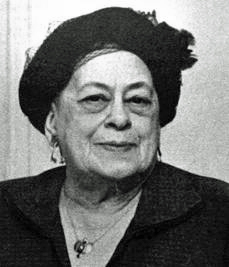Hortense Gordon facts for kids
Quick facts for kids
Hortense Gordon
|
|
|---|---|
 |
|
| Born |
Hortense Crompton Mattice
24 November 1881 Hamilton, Ontario, Canada
|
| Died | November 6, 1961 (aged 79) Hamilton, Ontario, Canada
|
| Education | Cranbrook Academy of Art |
| Known for | Painter |
| Movement | Abstract expressionism, Painters Eleven |
| Spouse(s) |
John Sloan Gordon
(m. 1920–1940) |
Hortense Gordon (born Hortense Crompton Mattice) was a Canadian artist. She was born on November 24, 1881, and passed away on November 6, 1961. Hortense became famous for her abstract art later in her life. She was also a key member of a well-known art group called Painters Eleven.
Contents
Early Life and Art Journey
Hortense Gordon was born in Hamilton, Ontario. She was the youngest daughter in her family. Her parents, Sarah Louise Crompton and James Harvey Mattice, encouraged their children to be creative. Even when she was in public school, Hortense took art classes on Saturdays. She even won a scholarship for her talent!
Hortense had an older sister named Marion. They were known to be very competitive with each other. Despite their rivalry, both sisters loved making art.
In 1903, Hortense moved to a fruit farm near Chatham, Ontario. Here, she learned to paint on china. She realized this was a skill she could use to earn money. So, she rented a studio to sell her unique china pieces. She also taught art to people in the area.
Her first art show was in December 1908. For many years, Hortense taught at the Hamilton Technical School. She was always looking for chances to show her art. People admired her china work and her growing collection of Canadian landscape paintings.
Marriage and European Travels
In 1916, Hortense's father passed away. She returned to Hamilton for the funeral. There, she met John Gordon, who suggested she teach at the Hamilton Art School. She joined the staff in October 1918.
After dating for a few years, Hortense and John got married on August 3, 1920. The couple often traveled to Europe during the summers. These trips inspired Hortense greatly. She was influenced by European artists like those from the Barbizon School. Her landscape paintings became softer and more spontaneous.
Becoming an Abstract Artist
For almost 40 years, Hortense mostly painted landscapes and still life. But after her husband died in 1940, her art style changed a lot. She became much more free in her painting.
From 1941 to 1945, she studied at the Cranbrook Academy of Art. There, she learned from a famous abstract expressionist artist named Hans Hofmann. His friendship and teaching pushed her to try new things. She started to move away from strict realism.
Hortense began to explore non-objective painting. This means her art didn't try to show real objects. Instead, she painted cubist-inspired works. These paintings had sharp angles, straight lines, and lots of energetic movement.
Joining Painters Eleven
Her new style of art gained attention across Canada. In 1948, she was named honorary president of the Contemporary Artists of Hamilton. Soon after, in 1952, she joined the Painters Eleven. She was the oldest member of this important group.
Being part of Painters Eleven inspired her to create even more non-objective art. This group also gave her chances to show her work in big exhibitions. She displayed her art in New York and Toronto. She was also made a member of the Royal Canadian Academy of Arts.
Hortense Gordon spent her last ten years painting many artworks. She showed her art in various galleries across Ontario. In 1961, she became ill and passed away on November 6, 1961.
Art Shows and Collections
Hortense Gordon's art has been shown in many places.
Select Exhibitions
- 1994: The Robert McLaughlin Gallery (a show looking back at her work)
- 1993: Thames Art Gallery (another show looking back at her work)
- 1961: Gallery Moos, Toronto
- 1954: Windsor Art Gallery
- 1952: Philips Gallery, Detroit
- 1928: Norman C. Maynard, Hamilton
Selected Collections
Her artworks are kept in important art collections, including:
- National Gallery of Canada, Ottawa
- The Robert McLaughlin Gallery, Oshawa
- Thames Art Gallery, Chatham
- Art Gallery of Hamilton, Hamilton

